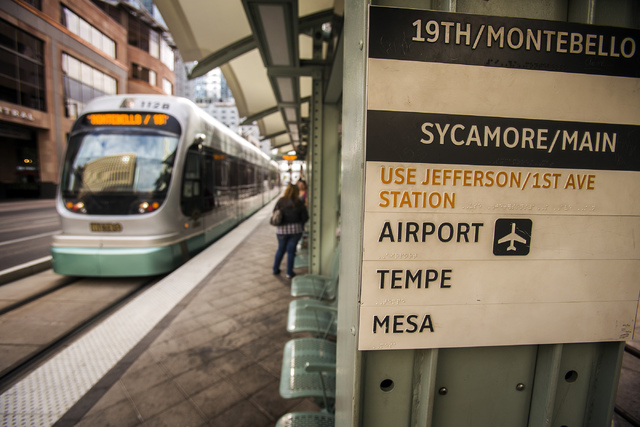Denver light-rail approach a model for Las Vegas transit
Fresh off a road trip to Denver to see that city’s growing light-rail system, members of the Regional Transportation Commission of Southern Nevada say they’d be the best agency to take the next step in developing a Southern Nevada system.
A group of 46 community leaders earlier this week toured rail facilities at downtown Denver’s Union Station and a new station at Denver International Airport that will open next month, creating a 23-mile rail link between the airport and downtown.
Local transportation planners have dreams of someday connecting McCarran International Airport with the valley’s resort corridor. With representation from elected officials from Clark County, the cities of Las Vegas, North Las Vegas, Henderson, Boulder City and Mesquite, the RTC board views itself as the best entity for taking the next step toward building a regional transit system.
“One of the things we heard over and over again in Denver is that it’s only achievable through collaboration,” said RTC General Manager Tina Quigley at Thursday’s monthly board meeting.
Transportation Commission Chairman Larry Brown, also a Clark County commissioner, said the regional makeup of the board makes it the most probable agency to move plans forward. However, Clark County could be in a lead position because so many proposals are already under county management, including street projects on and around the Strip and the airport.
“The RTC is not in the position to do the work, but it certainly would have an important role in driving everything forward,” Brown said. “That’s why I think the message of being collaborative and consensus driven is so important.”
Quigley said it would be key to not only get all the municipalities to buy into one strategy, but it would also be important to get the support of businesses and economic development leaders.
That could be a bigger challenge than it appears because the early stages of a light-rail project could be centered on the airport and the resort corridor and board members, elected by voters in their respective cities, might be asked to do what’s best for their constituents.
At Thursday’s meeting, for example, board members Debra March, a Henderson councilwoman, and Rod Woodbury, mayor of Boulder City, said that while they support a system that would serve tourists, they don’t want the residents of the valley to be forgotten when plans are drawn.
Board members delayed action on a plan to approve the final version of the RTC’s Transportation Investment Business Plan, an exhaustive document outlining several transportation options including mass transit and road development and ideas of how to pay for them. Board members will consider that in April and will ask municipalities to weigh in with their concerns.
Denver, which first began planning its light-rail system 30 years ago, ran its first train in 1994.
Denver’s Regional Transportation District had the challenge of dealing with 32 municipalities in the Denver area, but through the joint city and county government was able to pull together the financial resources to build the $2.2 billion expansion project.
Quigley said local officials will explore several funding options that Denver used, including seeking out federal grants — Denver got $1.1 billion — public-private partnerships that operate the system and possibly approaching voters to consider special tax districts or bond proposals. In Denver, voters approved an expansion plan in 2004 and the system also sold naming rights to the new line, known as the University of Colorado A Line, for $5 million.
In other business at Thursday’s board meeting, members evaluated Quigley’s 2015 performance and voted unanimously to give her a 6 percent raise.
The raise will increase Quigley’s annual salary from $222,268 to $235,664.
Contact Richard N. Velotta at rvelotta@reviewjournal.com or 702-477-3893. Find him on Twitter: @RickVelotta.

















